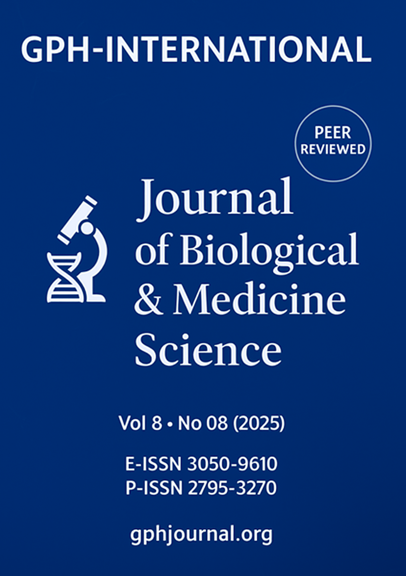ECOLOGY OF Utricularia aurea Lour. IN THE WATERS OF SRIWIJAYA UNIVERSITY, OGAN ILIR; NUMBER OF BLADDER, EMERGENCE AND INSPECTION OF PREY IN IT
Abstract
Shallow water ecosystems such as artificial ponds or swamps, especially on campus, play an important role in maintaining micro-ecological balance. These aquatic ecosystems contain unique aquatic plants that are rarely studied in depth, one of which is Utricularia aurea. Utricularia aurea has the ability to capture small organisms such as rotifers, copepods and even mosquito larvae in the early instar phase or stage. In general, the ecological research of Utricularia aurea at Sriwijaya University provides an understanding of its interaction with prey organisms in its natural habitat, as well as an opportunity to assess the potential of this plant as a biological control. This triggered curiosity to find out about the number of bladders, the initial position of bladder appearance in Utricularia aurea plants, and what types of prey are found in Utricularia aurea bladders in Sriwijaya University waters. The method used in this research is a combined method that includes quantitative and qualitative methods. The average number of bladders found on the tip of Utricularia aurea along 10 cm in the pond near the FISIP building of Sriwijaya University was 2,029 bladders while in Lake Unsri Taman Firdaus was 3,216 bladders. Bladder appears since the first modified leaf sequence although its shape is very microscopic. Prey found in the bladder of Utricularia aurea collected from Sriwijaya University waters for now found 5 prey which are Daphnia sp., Arrenurus sp., Closterium sp. as well as additional prey from the order Trombidiformes and Coleoptera which can only be identified to the order level.
Downloads
References
Adamec, L. (2011). Functional characteristics of traps of aquatic carnivorous Utricularia species. Aquatic Botany, 95(4), 226–233. https://doi.org/10.1016/j.aquabot.2011.05.009
Adamec, L. (2016). Mineral nutrition in aquatic carnivorous plants: Effect of carnivory, nutrient reutilization and K+ uptake. Fundamental and Applied Limnology, 188(1), 41–49. https://doi.org/10.1127/fal/2016/0848
Adlassnig, W., Peroutka, M., & Lendl, T. (2011). Traps of carnivorous pitcher plants as a habitat: Composition of the fluid, biodiversity and mutualistic activities. Annals of Botany, 107(2), 181–196. https://doi.org/10.1093/aob/mcq238
Guisande, C., Andrade-Sossa, C., Granado-Lorencio, C., & Nuñez-Avellaneda, M. (2000). Effect of zooplankton and conductivity on tropical Utricularia foliosa investment in carnivory. Aquatic Ecology, 34(2), 137–142. https://doi.org/10.1023/A:1009999310781
Daniken, A. K., Tiadona, C., Sadia, D. A., Sari, I. P., Fitri, L. A., Suro, M., Wulandari, N., Amelia, R., Citra, R. Y., Wati, S. S., Hikmah, U., & Nurokhman, A. (2025). Struktur sel, jaringan parenkim, meristem, penyokong, vaskular dan epidermis. Indramayu: PT Adab Indonesia.
Foissner, W. (2006). Biogeography and dispersal of micro-organisms: A review emphasizing protists. Acta Protozoologica, 45(2), 111–136.
Forbes, M. R., Muma, K. E., & Smith, B. P. (1999). Parasitism of Sympetrum dragonflies by Arrenurus planus mites: Maintenance of resistance particular to one species. International Journal for Parasitology, 29(6), 991–999. https://doi.org/10.1016/S0020-7519(99)00055-0
Haron, N. W., & Chew, M. Y. (2012). Medicinal and environmental indicator species of Utricularia from montane forest of Peninsular Malaysia. The Scientific World Journal, 2012, Article ID 234820. https://doi.org/10.1100/2012/234820
Jobson, R. W., Morris, E. C., & Lester, D. R. (2004). Carnivory and nitrogen supply affect the growth of the aquatic carnivorous plant Utricularia gibba. Functional Ecology, 18(2), 165–170. https://doi.org/10.1111/j.0269-8463.2004.00817.x
Manik, R. R. D. S., Setyono, B. D. H., Diamahesa, W. A., Dwiyanti, S., Affandi, R. I., Diniariwisan, D., Rahmadani, T. B. C., Mulyani, L. F., Wulan, W. A. S., Sumsanto, M., Basir, A. P., & Rumondang, A. (2024). Budidaya pakan alami. Makassar: Tohar Media.
Maryani, R., Norhayani, W., Wulandari, L., & Veronica, E. (2024). Perairan gambut Kalimantan Tengah untuk budidaya ikan patin (Pangasius sp.). Yogyakarta: Deepublish.
Mendoza-Roldán, J. A., Bezerra-Santos, M. A., Battesti, D. M. B., & Otranto, D. (2025). Acarofauna of Neotropical reptiles: Integrative morphology and vector competence of zoonotic pathogens. In C. Cantacessi (Ed.), Advances in parasitology (Vol. 127, pp. 1–42). London: Academic Press. https://doi.org/10.1016/bs.apar.2024.09.001
Mitsch, W. J., & Gosselink, J. G. (2007). Wetlands (4th ed.). Hoboken: John Wiley & Sons.
Mulyani, S. (2023). Buku ajar: Budidaya pakan alami (Tetraselmis sp. dan Daphnia moina sp.). Lombok Tengah: Penerbit Pusat Pengembangan Pendidikan dan Penelitian Indonesia.
Pandey, S. N., & Sinha, B. K. (2006). Plant physiology. New Delhi: Vikas Publishing House Pvt Ltd.
Pennak, R. W. (1953). Freshwater invertebrates of the United States. New York: The Ronald Press.
Pracaya. (2008). Hama dan penyakit tanaman. Jakarta: Penebar Swadaya.
Prescott, G. W. (1978). Fresh-water algae. London: W. M. C. Brown Company Publishers.
Simanjuntak, N. D., Suraya, U., & Buchar, T. (2020). Struktur komunitas jenis tumbuhan air Danau Hanjalutung. Journal of Tropical Fisheries, 15(1), 1–7. https://doi.org/10.35800/jtf.2020.15.1.1
Sirajuddin, N. T., Cengristitama, Alamsyah, R., Halijah, Ardiansyah, M., Marlina, L., Kurniawan, A., Haqqi, M. R. A., Sahar, R. A., & Zulkifli, A. T. A. R. (2024). Biologi perairan. Agam: Tri Edukasi Ilmiah.
Sopingi. (2015). Pengantar statistik pendidikan. Malang: Gunung Samudera.
Supranto, J. (2000). Statistik: Teori dan aplikasi. Jakarta: Erlangga.
Torre, D. (2019). Carnivorous plants. London: Reaktion Books.
Więcek, M., Broda, Ł., Proctor, H., Dabert, M., Smith, B. P., & Dabert, J. (2023). Species boundaries among extremely diverse and sexually dimorphic Arrenurus water mites (Acariformes: Hydrachnidia: Arrenuridae). Systematic and Applied Acarology, 28(2), 322–342. https://doi.org/10.11158/saa.28.2.9
Author(s) and co-author(s) jointly and severally represent and warrant that the Article is original with the author(s) and does not infringe any copyright or violate any other right of any third parties, and that the Article has not been published elsewhere. Author(s) agree to the terms that the GPH Journal will have the full right to remove the published article on any misconduct found in the published article.























